by Lydia J van Vuuren
“The starting point for a new life of art can come only by direct stimulation from the spiritual world. We must become artists, not by developing symbolism or allegory, but by rising, through spiritual knowledge, more and more into the spiritual world.”
Rudolf Steiner
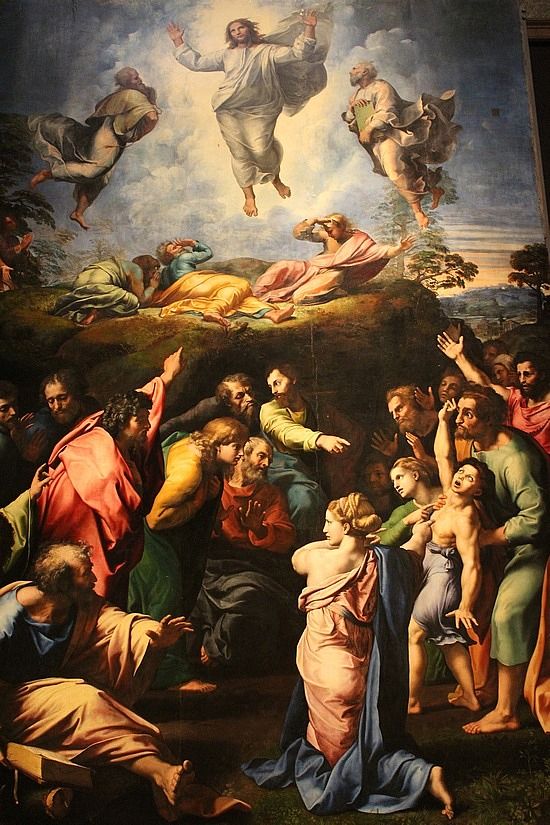
The Transfiguration by Raphael, Vatican
Introduction
If we think about the arts, what image or soul experience does it conjure? When we encounter something truly artistic, something profoundly meaningful enters our soul. We feel inspired, nurtured and filled with the notion that we are part of something larger than life. Let us think about some of the great masters in human history for a moment. Michelangelo, Leonardo da Vinci, Raphael, Rodin, Dante, Shakespeare, Yeats, Bach, Mozart, Handel, Beethoven to name but a few. When one reflects on their lives and work, one cannot help but to feel a sense of elevation and awe. One is overcome with an intuitive sense that here something has manifested on an earthly plane that is of profound significance for human development and evolution. Why is this? Why does the truly artistic have such a profound influence on our inner world?
Here follows an essay on Rudolf Steiner and his visionary view of the connection between the arts, cognition and spiritual life and the vital role of the arts in our human evolutionary journey. I have quoted Rudolf Steiner quite extensively in this blog. The reason being that he often used poetic language to convey a certain deeper spiritual meaning to the reader. I felt that this deeper meaning and the beauty would be lost if it had been rewritten in another way.
Today we live in a world of intellectual abstractions with little connection to the worlds beyond the visible. It wasn't always so. In ancient times people had an intuitive connection with the spiritual realms. However, as time passed humanity lost the direct intuitive perception of being part of a larger spiritual truth. Epochs passed and we became increasingly earthbound and disconnected to the spiritual cosmic laws, seasonal rhythms and natural forces underlying our human existence. This continued until today where we find ourselves in a present where people live in a disconnected over-intellectualized society devoid of meaning and without a sense of belonging to a greater truth. It is important though to remember that we do not want to negate the importance of the intellect. The development of abstract thought, even if it was at the cost of everything else, was a necessary occurrence in human development. However, today the time has come for humanity to find the way back to our true spiritual home. We need to connect once again with the underlying divine cosmic order like the old masters. Only this time it will be from a completely new perspective.
So how would humanity heal its broken connection with the divine spiritual worlds? In this regard, Anthroposophy leads the way. One of the main aims of Anthroposophy is to lift us out of our earthbound existence. It wants to guide us towards soaring into the heavenly spiritual realm once again with the arts as our heavenly chariot carrying us across the cosmic abyss between cognition and the spiritual worlds. True artistic activity is inspired by a divine impulse and connection. By engaging and imbuing our life with true artistic spiritual endeavor expressing itself in true artistic activity we will find the way to our heavenly home.
Let us look now at humanity's soul experience over the epochs as defined by Anthroposophy and follow the evolutionary course of how we became so disconnected to the spiritual world.
The 'I' or sense of 'Self' over the epochs
Please read the blog on 'Who Am I?' for an Anthroposophical understanding of the 'I' or ego and the soul.
Ancient India
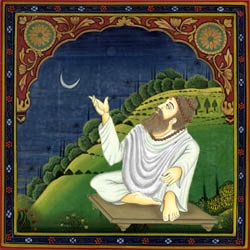 The people of ancient India during the first post-Atlantean epoch following the great Atlantean catastrophe did not experience the 'ego' or the 'self' as a point comprising all their experiences. The human in ancient India was connected to the cosmic heavenly realm. His deepest security and sense of self-were seated in the fixed starry patterns, the movement of the planets and the interplay of the sun and the moon. The human body belonged to the earth and was only a garment but the 'self' or the 'ego' was not from this world. You can say that the ancient Indian people had a divine ego.
The people of ancient India during the first post-Atlantean epoch following the great Atlantean catastrophe did not experience the 'ego' or the 'self' as a point comprising all their experiences. The human in ancient India was connected to the cosmic heavenly realm. His deepest security and sense of self-were seated in the fixed starry patterns, the movement of the planets and the interplay of the sun and the moon. The human body belonged to the earth and was only a garment but the 'self' or the 'ego' was not from this world. You can say that the ancient Indian people had a divine ego.
Ancient Persian
In the second epoch which Rudolf Steiner calls Ancient Persian, the divine cosmic ego of the ancient Indians has changed to a more earthly perception. An elemental consciousness arose. During this time the 'ego' found its security and sense of 'self' in the seasons of the year. The nature forces active during winter, spring, summer and autumn were felt and experienced deeply. The seasonal festivals came into being and celebrated the nature and essence of each season. The experience of the earth, the nature forces and the seasonal changes throughout the year were powerful spiritual experiences and governed their sense of self.
Egypto-Chaldean Period
Folk Consciousness versus family generational identity
In the Egypto-Chaldean epoch - the third period after the Atlantean epoch - the divine cosmic ego of the ancient Indians, as well as the elemental consciousness of the Ancient Persians, no longer played a significant role in the inner soul life of the human being. It is during this epoch that the folk consciousness rose to significance.
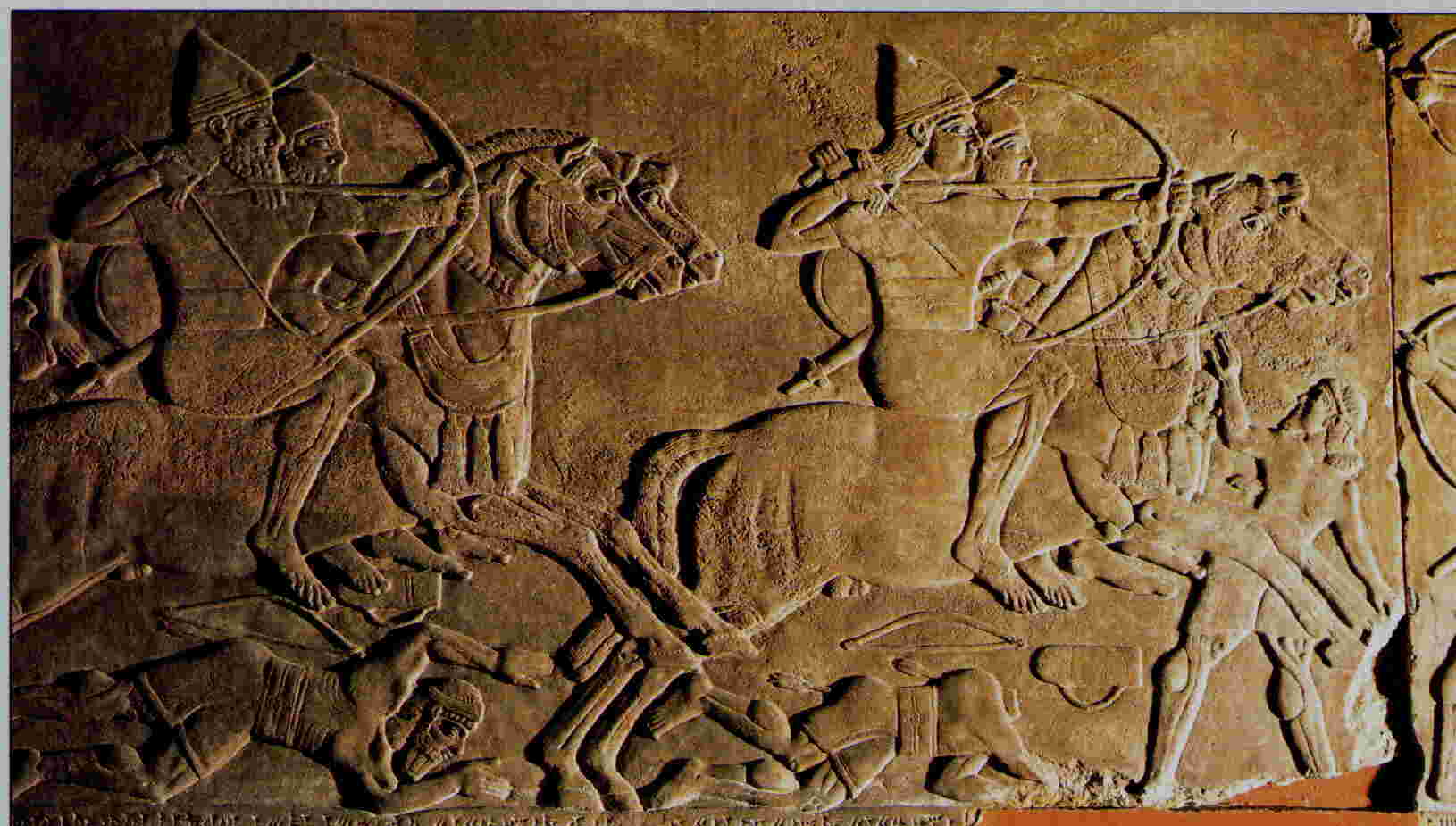 People in Ancient India did not have a folk consciousness. They didn't identify themselves with a 'people' or a 'folk'. There was some kind of sense of being with other people but nothing as defined as a group of people identifying themselves as a clan, folk or a nation. Instead, people saw themselves in terms of their generations and their family heritage. They experienced themselves vividly within their family circle and where they found themselves in the succession of generations.
People in Ancient India did not have a folk consciousness. They didn't identify themselves with a 'people' or a 'folk'. There was some kind of sense of being with other people but nothing as defined as a group of people identifying themselves as a clan, folk or a nation. Instead, people saw themselves in terms of their generations and their family heritage. They experienced themselves vividly within their family circle and where they found themselves in the succession of generations.
Assyrian Warriors
Slowly over the ages a sense of belonging to a 'people' or a folk consciousness grew stronger and became more pronounced as the sense of being part of family generations, being part of the starry cosmic world and the elemental consciousness faded.
How people viewed the nature of thoughts and the descent into the body.
Now let us look at how people viewed their thoughts and how it changed over the ages and influenced the way we humans experience ourselves.
According to Steiner people from the earliest ages until the millennium before the rise of Christianity knew that thoughts governed and permeated our world. They also knew that thoughts do not originate in the brain but that it belongs to and arises from a global collective thought realm which we are all connected to and that thoughts enter our being with the head as the vessel.
Even though the divine ego and the elemental consciousness were lost and people were becoming increasingly bound to the earth, the human being in the Egypto-Chaldean epoch still experienced spiritual universal thoughts (the Logos) in his etheric or life body. The human body was seen as a reflection of the sum total of human thought. As Steiner says it - the human being still had the immediacy of the Logos in his etheric body.
Greeks
During the Graeco-Latin period, humans descended into the earthly realm even more. The physical body became the primary focus. Steiner says this beautifully:
"Everything has its deep significance at its proper time, and in all the manifestations of Greek culture, we see this full, fresh penetration into the physical body. Especially in Greek art. For the early Greeks, their bodies were something to rejoice over; the Greeks were like children with new clothes. They lived in their bodies with youthful exuberance."
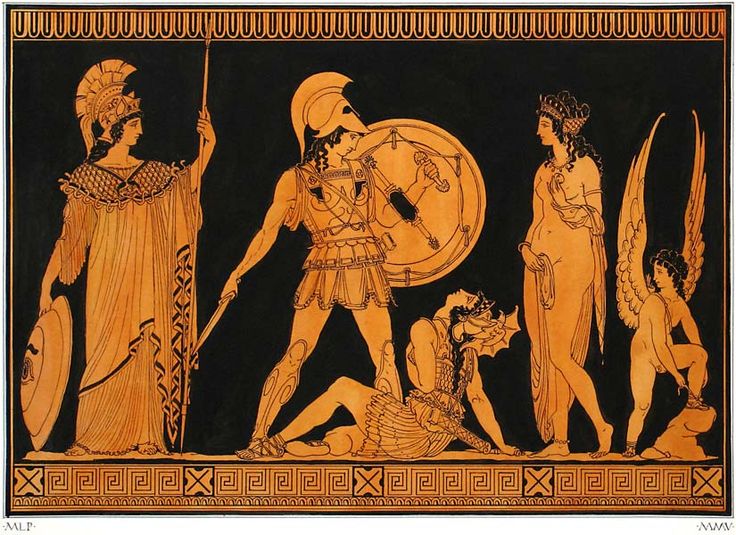
Ancient Greek painting, Achilles and Penthesileia on the Plain of Troy
Romans
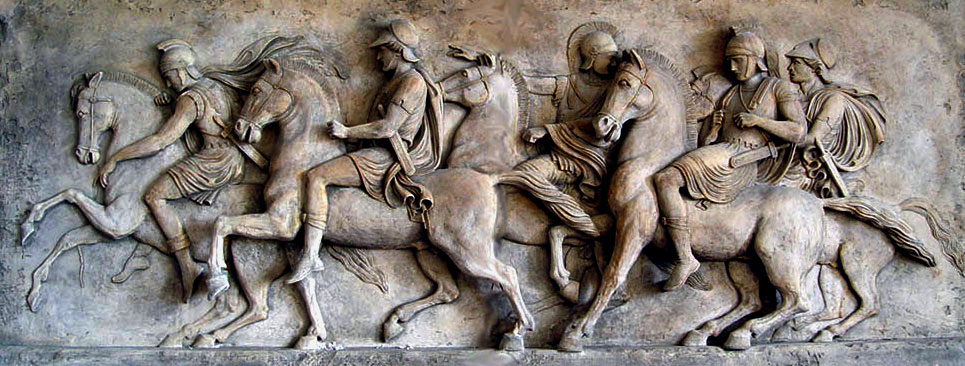 Ancient Roman Art
Ancient Roman Art
It was during the Roman period that a consciousness is more reflective of today's awareness settled in. The 'youthful' rejoicing over the bodily garment subsided and the earthly awareness settled in human consciousness. The earlier perception of the ego, astral body and the ether body was no longer present. It was during this period that the belief that thought originates in the human being itself became significant. The Greeks still knew the truth that thoughts were part of a collective thought world and that it lived in things rather than in people. *However in Roman times, this was lost. In this way, the descent into the physical became more and more pronounced.
* What comes to mind is the haunting story about how Archimedes' (one of the greatest mathematicians of ancient Greece) died. There are a few versions and what exactly happened is unclear. I will relate the one version which I find particularly poignant. It tells that Archimedes "was working on mathematical theories when Syracuse fell to the Roman army. When a Roman soldier came upon him drawing circles in the dust, the scholar said, "Do not disturb my circles!" Enraged at the mathematician's lack of deference, the soldier killed the old man.https://www.reference.com/art-literature/did-archimedes-die-2d05db3fcc4fd5a1
Today
In the fifteenth century (the start of the fifth post-Atlantean cultural epoch) this physical consciousness started to change. We are not aware of it yet, but since then humans have been moving away from the physical. As Steiner says:
"We fancy that we feel as the Greeks felt about the human shape, but actually our feeling for it is dull. We have no more than a shadow like the sensation of the “quick-footed Achilles,” and little understanding of how this expression roused Greeks to a direct and striking perception of the hero; so striking that he stood before them in his essential nature. Indeed in all art, we have gradually lost the experience of the permeation of the physical body by the soul..."
The truth is that human beings in today's world are uncertain about the nature of thoughts. Steiner says that our task as human beings in the present times is to find the divine-spiritual as something beyond the physical sense world. We must discover the divine as something special above our material world before we can once again find it in the sense world like the people in ancient times.
The Arts
The Spiritual and the Arts
In ancient times when there was still an intuitive clairvoyant connection with the spiritual world, art was seen as vital to civilization. Today people are no longer aware of the unity of spiritual life and art. Art is seen as something of a luxury and not vital to our quest for survival on this earth. This perception has profound implications on our evolution and way of living. One of the main goals of Anthroposophy is to change this perception and to permeate our lives once again with the arts. In our epoch the unity of the arts and the spiritual needs to be brought to life once again in order to restore the natural balance in our society.
What is True Art?
When Rudolf Steiner speaks about art he makes a clear distinction between 1) art inspired by a divine impulse and the human quest to transcend nature and its limitations and 2) a naturalistic art who attempts to merely copy nature and the natural world.
Rudolf Steiner argued that if we as humans contented ourselves with the notion that we are the highest creation in nature and nature is all there is then we would not have a displayed a deep inner need to transcend nature. We would not have composed sonatas, symphonies and operas since the songs of the birds would have been enough. If you look for example at the ancient Greek's quest to create an idealized human being, it points to an inner dissatisfaction with the status quo.
"...only a person who participates in spiritual life has an impulse for a creative activity transcending the merely natural. Otherwise, where would the impulse come from? In all ages, the human souls in which the artistic element flourished have had a definite relation to the spiritual world. It was out of a spirit-attuned state that the artistic urge proceeded. And this relates to the spiritual world will be, forever, the prerequisite for genuine creativity. Any age strictly naturalistic must, to be true to itself, become inartistic, philistine. Unfortunately, our own age has an immense talent for philistinism." R. Steiner
Art Forms in the Earthly Realm
Architecture
If we look at architecture today, the foremost motivation in architectural design is a utility. It is not often that you find that the design was inspired by a divine impulse to transcend the earthly. In the early ages, this was different. The designs of buildings in ancient times were inspired by a spiritual motivation and impulse. In order to understand this spiritual motive we need to look at the nature of the spiritual world and how it differs from our three-dimensional world of space, form and lines.
Steiner explains that the spiritual realm is a world of color and tone. There is not a space element and it is not three dimensional. It is a soul and spirit-permeated world of qualities and not of quantities. It is one of the intensities rather than extensions. When a soul leaves the body at death it was believed that it needed guidance to find its way back to the spiritual world. The soul must pass through the binding effect of the mineral, the animal, and the plant elements and it needs help to do so. It was believed that forms and lines would guide the soul from this three dimensional space and the binding elements to the spiritual world. Buildings were designed and built to provide these forms and lines to the newly departed soul for instance burial vaults, monuments and mausoleums. In this way, the soul could find its way back to the spiritual world after death.
"In ancient times, during mankind's evolution, these were religious-cultural anxieties. People pondered on what they had to do for souls, especially dear ones, to help them find the lines, planes, forms, by means of which they could reach the spiritual world. Thus was developed the art of erecting burial vaults, monuments, mausoleums, which embodied in their forms, their lines and planes, that which the discarnate soul requires if it is to be unimpeded by animals, plants and minerals when ready to find its way back to the spiritual world." R. Steiner
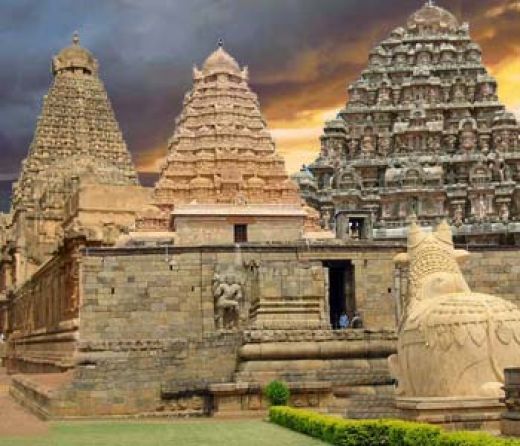
Ancient India
Costuming
Let us look now at the art of costuming. Ancient people were still very aware of the fact that their inner souls found this three dimensional earthly realm very strange. They needed something to remind them of the spiritual world from whence they came. As a result, they clothed themselves with the colors of the spirit world where they descended from. They needed to bring the spiritual realm from which they came into this strange world with its space and forms. So the colors with which ancient civilizations clothed themselves point to birth or the entry into earth life while architecture points to the exit from this earth or death.
"Thus (I repeat) ancient garments reflected something brought down from pre-earthly existence, reflected a predilection for the colorful, for harmony; and we need not be astonished that at a time when insight into the pre-earthly has withered, the art of costuming has shriveled into dilettantism. For modern clothing hardly conveys the feeling that man wants to wear it because of the way he lived in pre-earthly existence. But if you study the characteristically vivid garments of flourishing primitive cultures you will see that clothing is or can be a fully justified and great art through which man carries something of his pre-earthly life into earth life; just as, through architecture, he would receive impressions relevant to space-free, post-earthly conditions." R. Steiner
Sculpture
Let us turn our attention now to sculpture and look at the shape of the human head from a spiritual point of view as an example of what Steiner meant when he said that the human shape or any living shape should be viewed with the understanding that it is an expression of the spiritual:
Steiner explained that the shape of the top of the head reflects our spiritual relationship to the heavens above us. The shape of our nose and the adjacent area reflects our spiritual relationship with the atmosphere and our breathing system. And how the mouth and the adjacent area is formed is connected to our spiritual relationship with digestion, nutrition and motion.
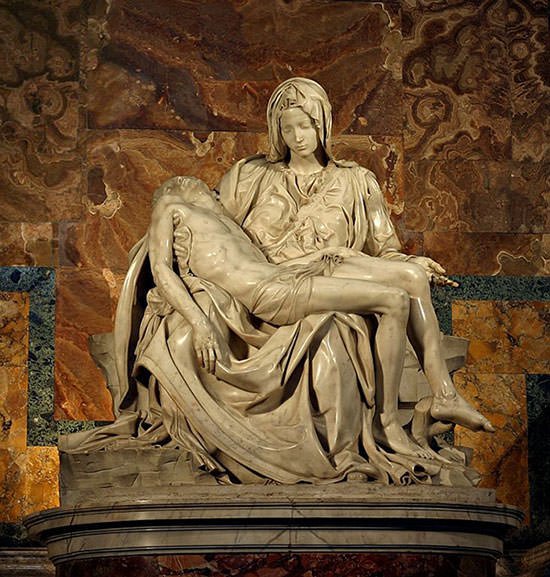
'Thus, in terms of European mythology, the head of the human being contains, above, as it were, Asgard, the castle of the gods; in its middle part, Midgard, man's earthly home; and, below, what also belongs to the earth, Jotunheim, home of the giants.' Rudolf Steiner
Pieta-1499- Michelangelo
Abstract concepts cannot explain these relationships and connections. It only becomes clear when you look at the human head as an artist inspired by a divine spiritual impulse. The artist for instance will look at the spherical shape of the head. He/She will look at the chin and see the spiritual quality it contains and describe it as 'advancing, obstinate and pointed' or 'it gently recedes.' The artist will look at the human form within a divine spiritual context and describe it thus.
The artist only views the shape of the human being artistically if there is an understanding that the form of the human being is in every respect an expression of the spiritual.
Summary
'To sum up: in sculpture we behold, spiritually, the human being as he is placed into the present; in architecture, we behold something connected with his departure from the body; and in the art of costuming something connected with his entrance into that body. Which means a sharp contrast: whereas architecture begins with the erection of tombs, sculpture shows how man, through his earthly form's direct participation in the spiritual, constantly overcomes the earthly-naturalistic element, how, in every detail of his form and in its entirety, he is an expression of the spiritual.
Thus we have considered those arts which are concerned with spatial forms and which illustrate the different ways in which the human soul is related to the world through the physical body." R. Steiner
A step closer to the spaceless
Painting
'If we approach a step nearer the spaceless, we pass from sculpture to painting, an art experienced in the right way only if we take into full account its special medium." R. Steiner

The Last Supper by Leonardo da Vinci
Steiner explained that the main problem of the artist painters of our current time is a lack of understanding of the true nature of colors. The painting has lost its connection with the divine spiritual world and tends to naturalism. After the arrival of the fifth epoch, people developed space-perspective. A painting or a drawing on a two dimensional plane could have the illusion of a three dimensional character if the painter followed certain mathematical rules. Steiner says although this was a necessary evolutionary development it was at the cost of a deeper understanding and application of color. Although space perspective should be understood and applied in painting, it should be emphasized that it is the colors which are the primary medium of artistic expression of the painter. Colors are spiritual and have deeper spiritual qualities. It is here where the focus of the painter should be. Red and yellow for instance have a lot of energy and movement and pushes forward. Violet and blue withdraw into the abyss. On the two dimensional plane of a canvas, the painter should strive to express movement through interaction with the colors. Color perspective is more important than spatial perspective. It is through the color perspective that the spiritual world manifests.
If we think about how dimensions in the physical realm differ from the dimensions in the etheric realm we will remember that when we rise from the physical three dimensional reality into the etheric, we will find a two dimensional realm. The depth aspect or the third dimension in this two dimensional realm is expressed through colors. Different shades of red, yellow, blue and violet express distance and movement as described above. By gaining an understanding of the true nature of colors we can overcome the spatial and rise from the spatial arts to the two-dimensional. The feelings of the sentient soul also exist within two dimensions. They have no relation to space. It is only our will that functions in space. That is why paintings are such a good medium for expressing feelings.
'You see, we have to struggle free from three-dimensional matter if we would advance from architecture, costuming as an art, and sculpture. Painting is an art which man can experience inwardly. Whether he creates as a painter or just lives in and enjoys a painting, it is a soul event. He experiences inner by outer; experiences color-perspective. We cannot say, as in the case of architecture, that the soul is striving to create the forms it needs when it gazes back into the body; nor, as in the case of sculpture, that the soul is trying to depict man's shape in such a way that it is placed into space full of present meaning. None of this concerns painting. It makes no sense in painting to speak of anything as inside or outside; of the soul as inside or outside. In experiencing color the soul is within the spiritual. Really, what is experienced in painting — despite the imperfections of pigments — is the soul's free moving about in the cosmos.' R. Steiner
Entering the Spaceless
Music
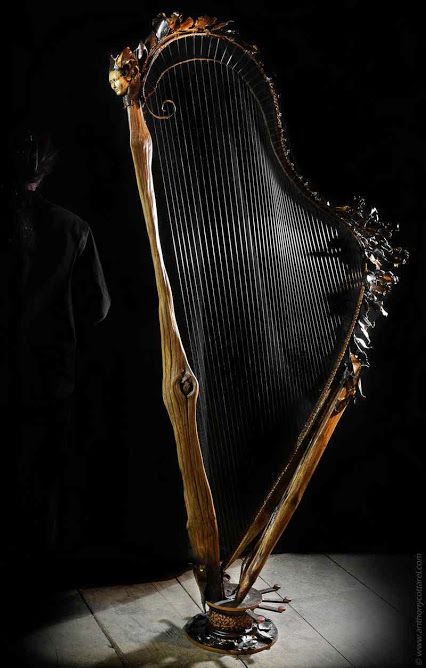 Who of us haven't been transported by beautiful music to another world that transcends our ordinary existence? The reason why we find music so immensely meaningful and satisfying is because with music we enter into the very fabric of the unconscious will that drives our existence. (Please see my blog Thinking, Feeling and Willing for the Anthroposophical explanation of the word 'will'.) Harmonies, tones and sounds have their origin in the spiritual worlds and are part of the elemental archetypal being of the cosmos.
Who of us haven't been transported by beautiful music to another world that transcends our ordinary existence? The reason why we find music so immensely meaningful and satisfying is because with music we enter into the very fabric of the unconscious will that drives our existence. (Please see my blog Thinking, Feeling and Willing for the Anthroposophical explanation of the word 'will'.) Harmonies, tones and sounds have their origin in the spiritual worlds and are part of the elemental archetypal being of the cosmos.
'In music, man feels the echo of the inmost life of things, a life related to his own. Because feelings are the most inward part of the soul, and because they are related to the spiritual world and are indwelt by musical sound — that is why man, when he listens to music, lives in the pleasure of feeling himself in harmony with its tones, and in touch with the true home of his spirit. So, when someone lives in the experience of music, he is living in the image of his spiritual home. It naturally elevates the soul to feel this intimate relationship to its primal ground, and that is why the simplest souls are so receptive to music. A man then feels himself truly at home, and whenever he is lifted up through the music he says to himself: “Yes, you come from other worlds, and in music, you can experience your native place.” It was an intuitive knowledge of this that led Schopenhauer to assign to music a central place among the arts, and to say that the composer discerns with his spiritual ear the pulse-beat of the Will.'
Celtic Harp
'Studying the secrets of music, we can discover what the Greeks, who knew a great deal about these matters, meant by the lyre of Apollo. What is experienced musically is really man's hidden adaptation to the inner harmonic-melodic relationships of cosmic existence out of which he was shaped. His nerve fibers, ramifications of the spinal cord, are marvelous musical strings with a metamorphosed activity. The spinal cord culminating in the brain, and distributing its nerve fibers throughout the body, is the lyre of Apollo. Upon these nerve fibers the soul-spirit man is “played” within the earthly sphere. Thus man himself is the world's most perfect instrument; and he can experience artistically the tones of an external musical instrument to the degree that he feels this connection between the sounding of strings of a new instrument, for example, and his own coursing blood and nerve fibers. In other words, man, as nerve man, is inwardly built up of music, and feels it artistically to the degree that he feels its harmonization with the mystery of his own musical structure.' R. Steiner
Into Our Innermost Secret
Poetry and Drama
To understand the significance of poetry we need to go back to ancient times. The spiritual evolution of humankind is fueled by the unity of science, art and religion. Nowadays science, art and religion have separated. However, there was a time where they clearly originated from a common source. This common source was most visible in ancient times in an art form what we today would call poetry. To understand the poetry of ancient civilizations we need to look at their spiritual development in those times by studying the mysteries.
We remember that in ancient times people found their spiritual identity or sense of self in the cosmic heavens. It was the starry expanse of the universe that gave their existence meaning. 'At that period those with clairvoyant faculties, seeing the fixed stars and movements of the planets, considered everything on earth a reflection of events taking place in its cosmic environment.' R. Steiner
Now when ancient people received spiritual content from the starry heavens they expressed it in the form of poetry. In these times all other art forms were undeveloped and existed only in a 'rudimentary state'. People were deeply conscious of the fact that words originated from their innermost holy mystery and that it was a worthy medium to express great spiritual truths - much more so than elements taken from the natural world. Poetry was inspired by a deep spirituality and contained spiritual truths. So first there was the word inspired by the divine. Then later this got poured into the other arts.
'This soul-communion constituted the poetic mood. Through it man saw how thoughts not yet separated from objects gain pictorial expression in his vault-like head, a head resembling the firmament; how thought represents a spiritual firmament, a celestial vault; how thought is inherent throughout the cosmos. Individual thoughts were expressed through the relative positions of the stars, by the way, the planets moved past each other. In those ancient times man — unlike the freeman of a later age — did not think merely by virtue of his own inner force. In every thought-movement, he felt the after-image of some star-movement, in every thought-form the after-image of a constellation. Thus his thinking transported him into stellar space.' R. Steiner
In the following quote of Rudolf Steiner, you will gain a better understanding of the actual spiritual symbolism that was present in the poetry and drama of ancient times. He describes it beautifully.
"Epic poetry turns to the upper gods, drama to the lower gods. True drama shows the divine world lying below the earth, the chthonic world, rising up onto the earth for the reason that man can make himself into an instrument for the action of this netherworld. In contrast, epic poetry sees the upper spiritual world sink down; the Muse descends and, making use of man through his head, proclaims man's earthly accomplishments or else those out in the universe. In drama the subterranean will of the gods rises up from the depths, making use of human bodies in order to give free reign to their wills.
One might say: Here we have the fields of earthly existence: out of the clouds descends the divine Muse of epic art; out of earthly depths there rise, like vapor and smoke, the Dionysian, chthonic divine-spiritual powers, working their way upward through men's wills. We have to penetrate earth regions to see how the dramatic element rises like a volcano, and the epic element sinks down from above, like a blessing of rain. And it is right here on this same plane with ourselves that the cosmic element is enticed and made gay, joyous, full of laughter, through nymphs and fire spirits; right here that the messengers of the upper gods cooperate with the lower: right here in the middle region that man becomes lyrical. Now man does not feel the dramatic element rising up from below, nor the epic element sinking down from above; he experiences the lyrical element living on the same plane as himself: a delicate, sensitive, spiritual element, which does not rain down upon forests nor erupt like volcanoes, splitting trees, but, rather, rustles in leaves, expresses joy through blossoms, wafts gently in wind. In whatever on our own plane lets us divine the spiritual in matter, stretching hearts, pleasantly stimulating breath, merging our souls with outer nature, as symbol of the soul-spiritual world — in all this there lives and weaves a lyrical element which looks up, with happy countenance, to the upper gods, and down, with saddened countenance, to the gods of the underworld. The lyrical can tense up into the dramatic-lyrical or quiet itself down into the epic-lyrical. For the hallmark of the lyrical, whatever its form, is this: man experiences what lives and weaves in the far reaches of the earth with his middle nature, his feeling nature." R. Steiner
Poetry is only poetry when it is connected to the divine eternal cosmic heavenly reality. There has to be symbolism, sound, rhythm, beat and imagination. True poetry communicates something which is beyond mere words. '...poetry conveys something lying outside its words, for which the words are but a means, the fact that poetry's aura of mood echoes cosmic harmony, melody, imagination, this fact, even today, makes poetry poetry.' R. Steiner
Today we need to recapture the poetic mood of the divine in our poetry. It has gotten lost to a large degree over the ages.
Eurythmy (Movement)
With Eurythmy the inner world of the word and the spaceless world of music are made visible through gesture. It is an art form that evolved from Anthroposophy in early 1900. It needs to be emphasized that it is not a dance form as some people believe.
Rudolf Steiner explained it in the following way. All vowels originate from the soul. Consonants, on the other hand, come into being from our perception and imitation of the external objects. He says that we actually imitate objects in our environment in the way we shape the stream of the breath with our teeth, tongue and palate or manipulate it with our lips. When we speak we are creating gestures in the air by the way of forming consonants. The vowels are the vehicle carrying the soul-life of the individual.
In the same way we create sentences and poetic language and it becomes actual gesture in the air. When language is viewed in terms of gesture Rudolf Steiner says that it becomes very clear how modern poets are struggling against the abstract element that has found its way into the language.
We do not experience the qualities of each letter in everyday conversation. Yet the qualities inherent are present. If we experience all the sounds in a given word we would enter into the real nature of the word as it originally arose out of the inner soul of the human being. We can then '...experience all possible shades of feeling, the ecstasy of joy, the depths of despair; we can experience the ascending and descending of the whole scale of the human emotions...'
Sounds in Eurythmy are expressed by using the arms and the hands according to an imaginative perception of the gestures made in the air by the stream of breath and the manipulation of the mouth forming the consonants. Thus creating a visible language.
So you can see that Eurythmy arises from the human being in just as natural a way as speech itself. The artistic must always be present. It is the soul qualities that are being expressed - audibly through speech and visibly through Eurythmy.
Eurythmy can also by accompanied by instrumental music or singing.
The Arts and crossing the Abyss
It is only from a direct connection with the spiritual that in the human's inner core the true creative impulse is born. True art finds itself between the eternal cosmic truths on the one hand and pure genuine religious life on the other. "Through knowledge and religion man draws closer to the spiritual element in thought, feeling and will." R. Steiner
When we look at our earthly world and our physical bodies we perceive that our physicality is not all there is. In many ways this world seems foreign to us and we sense intuitively that we contain parts that came from different worlds. If we try to solve this problem of our existence through naturalistic scientific knowledge we soon realize the shortcomings of our physical senses. Now to investigate the worlds beyond the earthly is not without dangers. If a human wants to walk the path of awakening he first need to acquire what Steiner calls an inner steadiness in his thoughts, feelings and will. There is a certain threshold that needs to be crossed. Cognition is very important in this journey. Cognition helps us to realize the gravity of the search for a true relationship with the spiritual world. It stresses the fact that one must travel a road of purification before passing the gate to the spiritual world. It also highlights the fact that if this natural world was all there is we would have been satisfied with it.
Religion, on the other hand, awakens man to the divine spiritual nature which he carries within himself. It brings meaning to his earthly existence by placing his life in an eternal context. Religious life leads far beyond the facts observable by a person with only ordinary earthly consciousness.
When man stands before religion on the one hand and cognition on the other, there is an abyss opening before him. Fortunately this abyss can be bridged - not by contemporary religion or cognition or by some or other science derived wholly from the earth. It is the Arts that becomes the vehicle carrying us across the abyss to the divine spiritual worlds.
'That is why art must realize that its task is to carry the spiritual-divine life into the earthly; to fashion the latter in such a way that its forms, colors, words, tones, act as a revelation of the world beyond. Whether art takes on an idealistic or realistic coloring is of no importance. What it needs is a relationship to the truly, not merely thought-out, spiritual. No artist could create in his medium if there were not alive in him impulses springing from the spiritual world. This fact points to the seriousness of art, standing alongside the seriousness of cognition and religious experience. It cannot be denied that our materialistically oriented civilization diverts us, in many ways, from the gravity of art. But any devoted study of true artistic creation reveals it as an earnest of man's struggle to harmonize the spiritual-divine with the physical-earthly.' R. Steiner
Conclusion.
I would like to end this article with a quote of Steiner. It words the inner need of Anthroposophy to guide humankind once more to a true experience and connection with the spiritual worlds and the cosmic divine universe. It wants to rekindle the flame of life and truth which has gone missing in our present times of abstract intellectualism and materialism.
"You see, if we really enter the spirituality of world phenomena, we gradually transform dead abstract concepts into a living, colorful, form-bearing weaving and being. Because what surrounds us lives in the artistic, mere intellectual activity can, almost unnoticed, be transformed into artistic activity. That is why we constantly feel a need to enliven impertinently abstract conceptual definitions — physical body, ether body, astral body, all such concepts, these impertinently rigid, philistine and horribly scientific formulations — into artistic color and form. This is an inner, not merely outer, need of Anthroposophy.
Therefore the hope may be expressed that all mankind will extricate itself from naturalism, drowned as it is in philistinism and pedantry through everything abstract, theoretical, merely scientific, practical without being really practical. Man needs a new impetus. Without this impulse, this swing, Anthroposophy cannot thrive. In an inartistic atmosphere it goes short of breath; only in an artistic element can it breathe freely. Rightly understood, it will lead over to the genuinely artistic without losing any of its cognitional character." R. Steiner
References
Rudolf Steiner Archive & e.Lib. 2007. The Arts and Their Mission. [ONLINE] Available at: http://wn.rsarchive.org/Lectures/GA276/English/AP1964/ArtMis_index.html. [Accessed 18 September 2017].
Rudolf Steiner Archive & e.Lib. 2002. A Lecture on Eurythmy. [ONLINE] Available at: http://wn.rsarchive.org/Lectures/GA279/English/RSP1967/19230826p01.html. [Accessed 18 September 2017].
Rudolf Steiner Archive & e.Lib. 1961. The Inner Nature of Music, and the Experience of Tone. [ONLINE] Available at: http://wn.rsarchive.org/Lectures/19061203p01.html. [Accessed 19 September 2017].
RALPH, J. (2009) Discover Eurythmy Frequently Asked Questions [online].
Aberdeen: Discover Eurythmy. Available from
www.eurythmy.org.uk/assets/defaq.pdf [Accessed 18 September 2017]
Images: All images have been sourced from the internet. If there are any copyright issues please contact me at creativemathforchildren@gmail.com
Note about the author
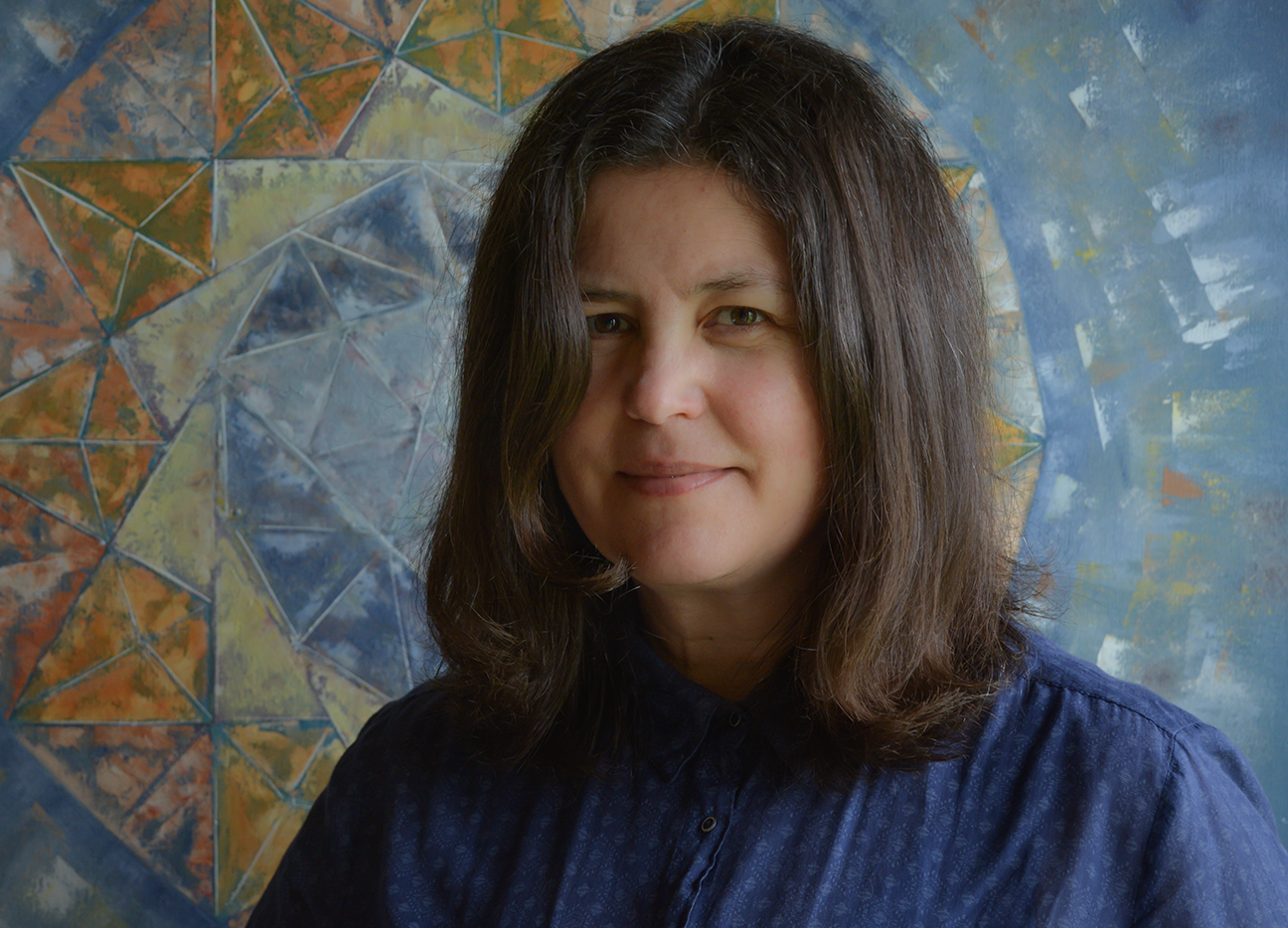
Lydia J van Vuuren has been a teacher in Waldorf Education for many years. She has a passion for the arts, mathematics and the spiritual. She blogs regularly on Rudolf Steiner and Waldorf Education. Go to www.creativemathforchildren.com to find out more.
The opinions expressed in this article are those of the author. The images are provided by author as public domain images under Creative Commons License.